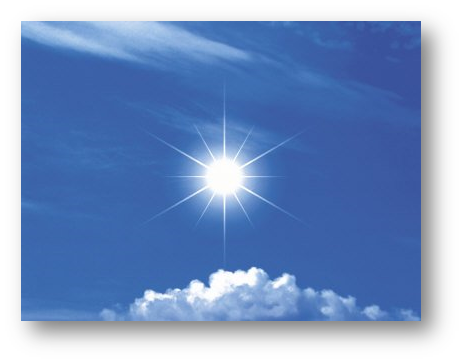
Indian culture and tradition is famous for its extra ordinary contribution in the field of science and spirituality since many years. The applications and importance of this knowledge based fields can be experienced through various customs and rituals celebrated in various parts of this country.
The month January is also called as “सहस्य or पौषमास” and is celebrated worshiping the Sun as ‘God’. So, here we are discussing about some of the scientific references of Sun, mentioned in Vedas which indicate the profound knowledge of our ancient sages and their scientific approach behind worshiping the Sun as God.
1) Concept of spectrum:
सप्तयुञ्जन्ति रथमेकचक्रमेको अश्वो वहति सप्तनामा || {ऋ.१.१६४.२}
When Prism spreading white light into a spectrum of light, the visible colors are in the order of the spectrum.

अनश्वो जातो अनभीशुरर्वा कनिक्रदत् पतयदूर्ध्वसानुः|| {ऋ.१.१५२.५}
Here the image of horse is just symbolical and not actual which is cleared by the verse, The chariot of sun consists of seven horses but lead by one horse.
2) Sun neither sets nor rises:
स वा एष न कदाचनास्तमेति नोदेति तं यदस्तमेतीति मन्यन्तेन्ह एव तदन्तमित्वाथात्मानं विपर्ययस्ते रात्रिमेवावस्तात् ………………………
…………कुरुते रात्रिं परस्तात् स वा एष न कदाचन निम्नोचति || {ऐ.ब्रा.१४.६}
The Sun remains constant. It neither sets nor rises. It shines at one side with day and at the same time, it is responsible for the darkness of its exact opposite side with night.
3) Sun – Source of Light and Energy:
आप्रा रजांसि दिव्यानि पार्थिवा श्लोकं देवः कृणुते स्वाय धर्मणे |
प्रबाहू अस्राक् सविता सवीमनि निवेशयन प्रसुवन्नक्तुभिर्जगत् || {ऋ.४.५३.३}
Sun provides Tej (light,energy and health) to Antariksha (Space) and Prithvi (Earth) which results into day and night.
4) Year, Month and Day:
द्वादश प्रधयश्चक्रमेकं त्रीणि नभ्यानि क उ तच्चिकेता |
तस्मिन्त्साकं त्रिशता न शंकवोsर्पिता षष्टिर्न चलाचलासः|| {ऋ.१.१६४.४८}
The chariot of Sun has 12 paridhi, 1 chakra, 3 nabhi and 360 aare. This indicates , 12 months, 1 year, 3 seasons and 360 days respectively.
5) Vedic Names of Months:
वेदमासो धृतव्रतो द्वादश प्रजावतः| वेदा य उपजायते || {ऋ.१.२५.८}
The journey of Sun gives birth to the twelve months, they are as follows,
मधुश्च माधवश्च वासन्तिकावृत शुक्रश्च शुचिश्च ग्रैष्मावृत नभश्च नभस्यश्च वार्षिकावृत
इषश्चोर्जश्च शारदावृतू सहश्च सहस्यश्च हैमन्तिकावृत तपश्च तपस्यश्च शैषिरावृत || {तै.सं.४.४.११}
| RUTU | VEDIC MONTH | MARATHI MONTH |
| वसन्त | मधु , माधव | Chaitra, Vaishakh |
| ग्रीष्म | शुक्र , शुचि | Jeshtha, Aashad |
| वर्षा | नभस् , नभस्य | Shravan, Bhadrapad |
| शरद | इष , उर्ज | Ashwin, Kartik |
| हेमन्त | सहस , सहस्य | Margshirsha, Paush |
| शिशिर | तपस , तपस्य | Maagh, Falgun |
Two more months are described in Vedas which comes after typical intervals of time:
“संसर्प” – अधिकमास, “अंहस्पति” – क्षयमास
[ससर्पोस्य अंहस्पत्यायत्वा || {तै.सं.१.४.१४}
There are many more facts related with Sun in Vedas which were acutely observed and mentioned by our great sages. There exists more than hundred verses of Sun in Rigveda and here we have stated only 5 of them.
Hence, Vedas are not only sacred or religious but it is the sea of knowledge. This literature is the pride of India. Also the customs and rituals we got from our ancestors are nothing but an effective method prepared by our great sages to pass on this knowledge to the next generation.
For example, the image of sun which is worshipped on “Makarsankranti” in every house in India is the same as we mention above. (Sr no.4).
Abbreviation :
ऋ. – ऋग्वेद
ऐ. ब्रा. – ऐतरेय ब्राह्मण
तै. सं. – तैत्तीरीय संहिता


Very nice……all are facts…
Very informative …..good explanation.
That’s the good thing that people will remind forgotten knowledge of our ancient people.
Good and easily understandable contents.
This brings us back to our own culture & forgotten knowledge and is a good reason to go back to our basics.
thanks
महत्त्वपूर्णं ज्ञानं विद्यते वेदै:। बहु उत्तमं प्रयत्नम्। अभिनंदनानि।
Good information
Useful information.. everyone should read this atleast once..
Nice…. Really informative
Well described the concept of Sun in Vedas in very precise and easy language. Eagerly waiting for future blogs.
Why do we Odiyas worship the Sun in January on Samba Dashami? Here’s the answer in one word; Perihelion. We are closest to Lord Surya on that day. While Indians knew this since the vedic times, modern science was gifted this knowledge by Kepler in the 17th century!
Hello Arya, this is an insightful and interesting fact demonstrating the richness of vedic knowledge. Really appreciate, you sharing with all. Thank you!
This has to be shared on large scale & vigorously on other available platforms in order to make it known globaly.
Very nice information
Very good information and simple explanation , good for the new generation to understand,
Excellent, what a webpage it is! This website provides valuable information to
us, keep it up.